+ Open data
Open data
- Basic information
Basic information
| Entry | Database: PDB / ID: 1rfr | ||||||
|---|---|---|---|---|---|---|---|
| Title | NMR structure of the 30mer stemloop-D of coxsackieviral RNA | ||||||
 Components Components | stemloop-D RNA of the 5'-cloverleaf of coxsackievirus B3 | ||||||
 Keywords Keywords | RNA / loop with conformation similar to stable UNCG-tetraloops and U:G closing base pair / base-paired U:U-C:U-U:U mismatch / A-form helix stems | ||||||
| Function / homology | RNA / RNA (> 10) Function and homology information Function and homology information | ||||||
| Biological species |   Human coxsackievirus B3 Human coxsackievirus B3 | ||||||
| Method | SOLUTION NMR / distance geometry, simulated annealing, energy minimisation | ||||||
 Authors Authors | Ohlenschlager, O. / Wohnert, J. / Bucci, E. / Seitz, S. / Hafner, S. / Ramachandran, R. / Zell, R. / Gorlach, M. | ||||||
 Citation Citation |  Journal: STRUCTURE / Year: 2004 Journal: STRUCTURE / Year: 2004Title: The structure of the stemloop D subdomain of coxsackievirus B3 cloverleaf RNA and its interaction with the proteinase 3C. Authors: Ohlenschlager, O. / Wohnert, J. / Bucci, E. / Seitz, S. / Hafner, S. / Ramachandran, R. / Zell, R. / Gorlach, M. | ||||||
| History |
|
- Structure visualization
Structure visualization
| Structure viewer | Molecule:  Molmil Molmil Jmol/JSmol Jmol/JSmol |
|---|
- Downloads & links
Downloads & links
- Download
Download
| PDBx/mmCIF format |  1rfr.cif.gz 1rfr.cif.gz | 367.4 KB | Display |  PDBx/mmCIF format PDBx/mmCIF format |
|---|---|---|---|---|
| PDB format |  pdb1rfr.ent.gz pdb1rfr.ent.gz | 308.8 KB | Display |  PDB format PDB format |
| PDBx/mmJSON format |  1rfr.json.gz 1rfr.json.gz | Tree view |  PDBx/mmJSON format PDBx/mmJSON format | |
| Others |  Other downloads Other downloads |
-Validation report
| Summary document |  1rfr_validation.pdf.gz 1rfr_validation.pdf.gz | 327.7 KB | Display |  wwPDB validaton report wwPDB validaton report |
|---|---|---|---|---|
| Full document |  1rfr_full_validation.pdf.gz 1rfr_full_validation.pdf.gz | 441 KB | Display | |
| Data in XML |  1rfr_validation.xml.gz 1rfr_validation.xml.gz | 8.2 KB | Display | |
| Data in CIF |  1rfr_validation.cif.gz 1rfr_validation.cif.gz | 15.8 KB | Display | |
| Arichive directory |  https://data.pdbj.org/pub/pdb/validation_reports/rf/1rfr https://data.pdbj.org/pub/pdb/validation_reports/rf/1rfr ftp://data.pdbj.org/pub/pdb/validation_reports/rf/1rfr ftp://data.pdbj.org/pub/pdb/validation_reports/rf/1rfr | HTTPS FTP |
-Related structure data
| Similar structure data |
|---|
- Links
Links
- Assembly
Assembly
| Deposited unit | 
| |||||||||
|---|---|---|---|---|---|---|---|---|---|---|
| 1 |
| |||||||||
| NMR ensembles |
|
- Components
Components
| #1: RNA chain | Mass: 9536.624 Da / Num. of mol.: 1 Source method: isolated from a genetically manipulated source Details: PROTEINASE 3C BINDING DOMAIN / Source: (gene. exp.)   Human coxsackievirus B3 / Genus: Enterovirus / Species: Human enterovirus B Human coxsackievirus B3 / Genus: Enterovirus / Species: Human enterovirus BDescription: two nucleotides (GG) at 5'-end and two nucleotides (UC) at the 3'-end were added for in vitro production Gene: 5'-nontranslated region / Plasmid: pUC-19 / Production host: in vitro (unknown) |
|---|
-Experimental details
-Experiment
| Experiment | Method: SOLUTION NMR |
|---|---|
| NMR experiment | Type: see below |
| NMR details | Text: the structure was determined using heteronuclear 2D and 3D NMR experiments, e.g. 3D HCCH-COSY, RELAY-COSY, TOCSY, H6/H5(C4N)H, C6/C5(C4N)H, H(CCN)H-TOCSY, HCCH-TOCSY, 2D H(N)CO, 2D CPMG-HSQC- ...Text: the structure was determined using heteronuclear 2D and 3D NMR experiments, e.g. 3D HCCH-COSY, RELAY-COSY, TOCSY, H6/H5(C4N)H, C6/C5(C4N)H, H(CCN)H-TOCSY, HCCH-TOCSY, 2D H(N)CO, 2D CPMG-HSQC-NOESY, 2D NOESY, 3D 1H,1H,15N-NOESY-HSQC, 3D 1H,1H,13C-NOESY-HSQC, CLEAN-TOCSY, 31P-SPINECHO-DIFFERENCE-CT-HMQC, HNN-COSY, 2D 1H,13C-HSQC, 2D 1H,15N-HSQC, HCN, H5(C5C4N)H, H8(C8C2)H2, 3D 13C-F1-FILTERED,13C-F3-EDITED-NOESY-HSQC |
- Sample preparation
Sample preparation
| Details |
| |||||||||||||||
|---|---|---|---|---|---|---|---|---|---|---|---|---|---|---|---|---|
| Sample conditions |
| |||||||||||||||
| Crystal grow | *PLUS Method: other / Details: NMR |
-NMR measurement
| Radiation | Protocol: SINGLE WAVELENGTH / Monochromatic (M) / Laue (L): M | |||||||||||||||
|---|---|---|---|---|---|---|---|---|---|---|---|---|---|---|---|---|
| Radiation wavelength | Relative weight: 1 | |||||||||||||||
| NMR spectrometer |
|
- Processing
Processing
| NMR software |
| ||||||||||||||||||||||||||||
|---|---|---|---|---|---|---|---|---|---|---|---|---|---|---|---|---|---|---|---|---|---|---|---|---|---|---|---|---|---|
| Refinement | Method: distance geometry, simulated annealing, energy minimisation Software ordinal: 1 Details: 1001 experimental distances derived from NOE cross peaks, 280 torsion angle constraints describing 258 torsion angles, 52 hydrogen bond constraints | ||||||||||||||||||||||||||||
| NMR representative | Selection criteria: closest to the average | ||||||||||||||||||||||||||||
| NMR ensemble | Conformer selection criteria: structures with the lowest energy,target function Conformers calculated total number: 100 / Conformers submitted total number: 20 |
 Movie
Movie Controller
Controller



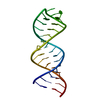



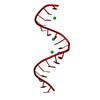


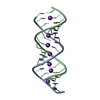
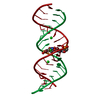
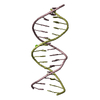
 PDBj
PDBj





























 CYANA
CYANA